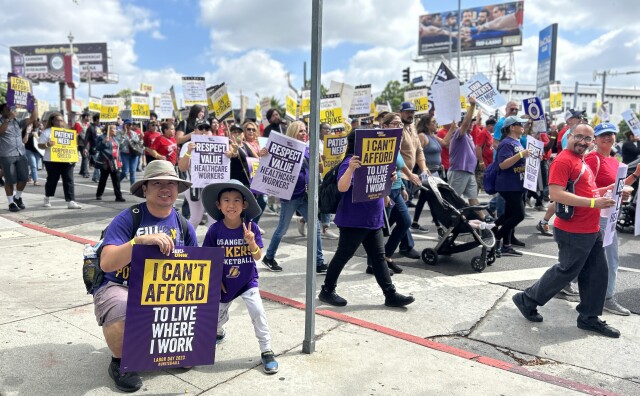California To End Sales Of New Gas Cars by 2035

Today, California Governor Gavin Newsom signed an executive order requiring that only zero-emission passenger vehicles be sold in the state as of 2035. That includes both cars and trucks.
“We will move forward to green and decarbonize our vehicle fleet here in the state of California,” said Newsom during a press conference.
“If you want to reduce asthma, if you want to mitigate the rise of sea level, if you want to mitigate the loss of ice sheets around the globe, then this is a policy for other states to follow,” he said.
People will still be able to own and resell gasoline powered cars even after the deadline.
By 2035, heavy duty trucks that transport items to and from ports – significant contributors of pollution for places like the Inland Empire – will also be required to be zero emission. And by 2045, that’ll apply to medium and heavy duty vehicles when possible.
Transportation is the largest contributor of greenhouse gas emissions in California, accounting for approximately 40 percent as of 2017. Passenger vehicles themselves are responsible for 28 percent, while heavy duty trucks are responsible for about eight percent.
Newsom said that there are an estimated 726,000 electric vehicles currently registered in the state, only a small portion of the 26 million cars in total.
NEW: We’re facing a climate crisis.
— Gavin Newsom (@GavinNewsom) September 23, 2020
We need bold action.
CA is phasing out the internal combustion engine.⁰
By 2035 every new car sold in CA will be an emission free vehicle.
Cars shouldn’t give our kids asthma.
Make wildfires worse.⁰
Melt glaciers.
Or raise sea levels.
“This would certainly have a large impact on the environmental justice issue of higher pollutants near freeways,” said Suzanne Paulson, Director of the Center for Clean Air at UCLA.
“It would take a while before it would have a big impact, because most of the pollution comes from cars that are six, ten yeras old, and trucks. It would take a while before we cycle out of the old more polluting vehicles.”
However, she said “it’s not a panacea,” when it comes to reducing fine particulate matter, known as PM2.5 – only one of the many pollutants released by vehicles across the region.
It’s the stuff that burrows deep into the lungs and spreads through the bloodstream, causing inflammation and causing problems with the immune response. Long term exposure can cause all sorts of issues, including an increased risk of cancer, heart disease, and chronic obstructive pulmonary disease.
There are both direct and indirect sources of PM2.5. Direct sources account for 30 percent of the fine particulate matter that we experience in the South Coast Air Basin. Of that, only 11 percent is attributable to light duty vehicles.
Indirect is more complex, as it forms in the atmosphere when nitrogen oxide, sulfur dioxide, ammonia and other volatile organic compounds are emitted by burning fossil fuels.
Nitrogen oxide is of particular concern and was mentioned by Governor Newsom as one of the pollutants that’ll be curbed. However, only 10 percent of it comes from light duty vehicles.
Other sources of all of the pollutants we inhale deep into our lungs include ships and trucks, manufacturing, construction, dust from roadways, consumer products, and the growing number of wildfires pummelling the region yearly.
“Reducing emissions in all sectors is necessary and should be applauded,” said Philip Fine, deputy executive officer with the South Coast Air Quality Management district. “It’s a great goal that the Governor has laid out. We support it 100 percent. We need to find ways to accelerate those emission reductions even sooner to meet our clean air goals.”
This story was updated to clarify the sources of fine particulate matter.
Our news is free on LAist. To make sure you get our coverage: Sign up for our daily newsletters. To support our non-profit public service journalism: Donate Now.
-
After San Gabriel's city council rejected the proposal as "too narrow", one city councilmember argued the entire DEI commission, created in the aftermath of George Floyd's murder, had "run its course."
-
A medical industry challenge to a $25 minimum wage ordinance in one Southern California city suggests health workers statewide could face layoffs and reductions in hours and benefits under a state law set to begin phasing in in June. Some experts are skeptical, however, that it will have such effects.
-
Sandhill cranes are returning to the Lake Tahoe basin after a century long hiatus in what many say is a conservation success story.
-
The Dodgers fired Mizuhara in March after Ohtani's lawyers accused him of stealing millions of dollars from the baseball player to place bets with an Orange County-based bookie.
-
Jackie’s partner, Shadow, refuses to abandon their unviable eggs, despite her attempts to nudge him along.
-
Big Sur's Highway 1 was built to maximize the breathtaking views of the cliffs and ocean at the cost of the road's longterm stability.






